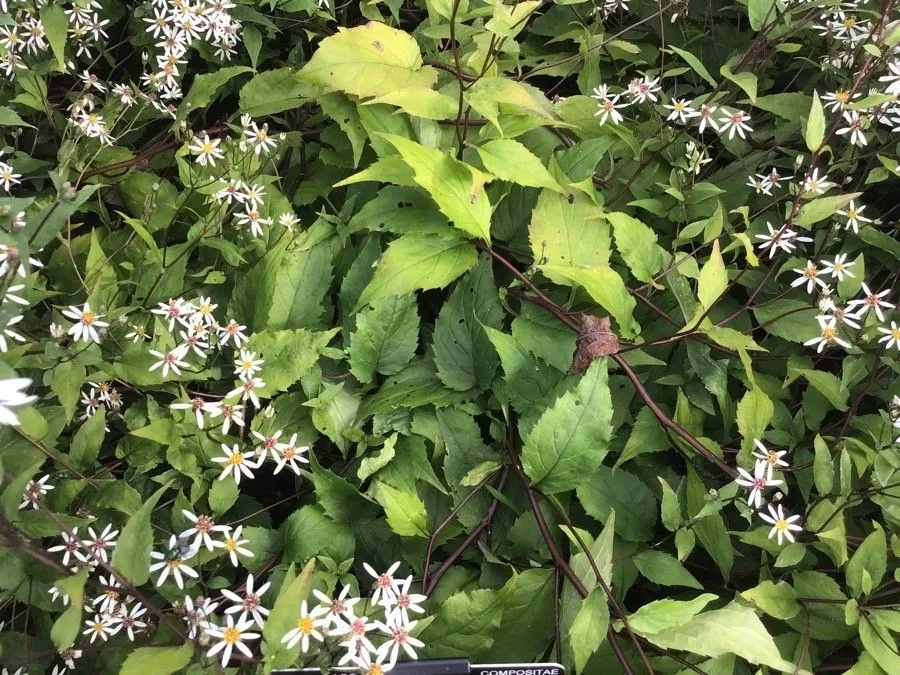
Author: (L.) G.L.Nesom
Bibliography: Phytologia 77: 259 (1995)
Year: 1995
Status: accepted
Rank: species
Genus: Eurybia
Vegetable: Unknown
Observations: E. Canada to U.S.A.
The White Wood Aster, scientifically known as Eurybia divaricata, is a captivating perennial herb belonging to the Asteraceae family. Its delicate yet resilient nature signifies the rich biodiversity found in the Eastern regions of Canada extending to the United States of America.
Eurybia divaricata thrives in the dappled light of woodlands, illuminating the forest floor with its starry white blossoms. The plant’s distinctive flowers bloom primarily in late summer to early fall, creating a striking contrast against the green foliage with their delicate white petals and vibrant yellow centers.
Characterized by its heart-shaped leaves that often contain serrated edges, the White Wood Aster exhibits a unique, arching growth pattern that allows it to spread gracefully across shaded woodland areas. This feature not only enhances the plant’s ornamental appeal but also plays a pivotal role in maintaining the forest ecosystem by providing ground cover and contributing to soil stability.
As part of the Asteraceae family, Eurybia divaricata shares a common heritage with a diverse group of flowering plants known for their composite inflorescences. This affiliation underscores the aster’s adaptability and ecological significance, contributing to the rich tapestry of flora within its native habitats from the temperate climes of Eastern Canada to the varied landscapes across the United States.
The botanical exploration and classification of Eurybia divaricata were detailed comprehensively in Phytologia, volume 77, page 259, in the year 1995, with the formal scientific description attributed to the taxonomist G.L. Nesom. This publication not only reinforces the plant’s taxonomic identity but also highlights its importance in botanical research and conservation efforts.
In preserving the natural beauty and ecological benefits of the White Wood Aster, it is imperative to protect its woodland habitats from deforestation and invasive species. Cultivating an understanding and appreciation of Eurybia divaricata can inspire efforts to conserve this enchanting woodland perennial, ensuring its presence for future generations to enjoy amidst the shaded groves of North America’s forests.
Eng: common white heart-leaf aster, heart-leaf aster, white wood aster, heart-leaved aster, white heart-leaved aster
Deu: spreizende waldaster, weiße wald-aster
Fra: aster corymbiforme, aster divariqué, aster à rameaux étalés
Swe: vit skogsaster
Nld: sneeuwaster
En: White wood aster, Common white heart-leaf aster, Heart-leaf aster, Heart-leaved aster, White heart-leaved aster, Heartleaf Aster
Nl: Sneeuwaster
Fr: Aster corymbiforme, Aster divariqué, Aster à rameaux étalés
De: Spreizende Waldaster, Weiße Wald-Aster
Sv: Vit skogsaster
Taken Oct 18, 2021 by FabyPhil (cc-by-sa)
Taken Aug 21, 2022 by rens rens (cc-by-sa)
Taken Sep 8, 2020 by Jan Van den Bossche (cc-by-sa)
Taken Oct 11, 2021 by Christophe Christophe (cc-by-sa)
Taken Oct 11, 2020 by Diego Alex (cc-by-sa)
Taken Sep 4, 2021 by Alfons Fi (cc-by-sa)
Taken Jun 26, 2022 by Alfons Fi (cc-by-sa)
Taken Jul 27, 2022 by Marc (cc-by-sa)
Taken Mar 23, 2022 by christine leblond (cc-by-sa)
Taken Oct 11, 2020 by Diego Alex (cc-by-sa)
Taken Aug 6, 2022 by Ha Anna (cc-by-sa)
Taken Aug 2, 2022 by Denisa Regine Novotná (cc-by-sa)
Taken Sep 3, 2022 by Petr Harant (cc-by-sa)
Taken Aug 4, 2022 by Camilla Maltas (cc-by-sa)
Taken Aug 15, 2005 by Photoflora – Jean-Luc TASSET (©)
Taken Oct 18, 2022 by Anatas (cc-by-sa)
Taken Oct 18, 2022 by Anatas (cc-by-sa)
Taken Jun 28, 2021 by Diurka A. (cc-by-sa)
© copyright of the Board of Trustees of the Royal Botanic Gardens, Kew.
© copyright of the Board of Trustees of the Royal Botanic Gardens, Kew.
Family: Myrtaceae Author: (F.Muell.) K.D.Hill & L.A.S.Johnson Bibliography: Telopea 6: 402 (1995) Year: 1995 Status:…
Family: Rubiaceae Author: Pierre ex A.Froehner Bibliography: Notizbl. Bot. Gart. Berlin-Dahlem 1: 237 (1897) Year:…
Family: Sapindaceae Author: Koidz. Bibliography: J. Coll. Sci. Imp. Univ. Tokyo 32(1): 38 (1911) Year:…
Family: Asteraceae Author: A.Gray Bibliography: Pacif. Railr. Rep.: 107 (1857) Year: 1857 Status: accepted Rank:…
Family: Fabaceae Author: Medik. Bibliography: Vorles. Churpfälz. Phys.-Ökon. Ges. 2: 398 (1787) Year: 1787 Status:…
Family: Aspleniaceae Author: (Cav.) Alston Bibliography: Bull. Misc. Inform. Kew 1932: 309 (1932) Year: 1932…